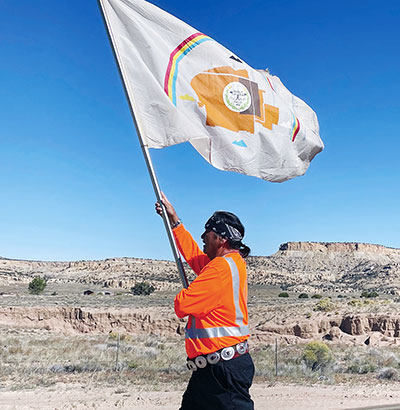
Spirit of the horse: On Indigenous Peoples Day, horseback riders travel 34 miles
WINDOW ROCK
Native horseback riders rode from Smith Lake to Rehoboth on Monday in honor of Indigenous Peoples Day.

Navajo Times | Hannah John
Kenneth Brown holds the Navajo Nation flag as he walks behind horseback riders on Monday. The ride was organized by Elmer Yazzie in honor of Indigenous Peoples Day, it started in Smith Lake, N.M., and ended at Rehoboth Christian School in Rehoboth, N.M.
The state of New Mexico began observing Indigenous Peoples Day in place of Columbus Day in 2019 when Gov. Michelle Lujan Grisham made it an official state holiday.
Since then, many Indigenous Peoples Day celebrations have taken place throughout the state.
This year, former Rehoboth Christian School Art Teacher Elmer Yazzie organized the 34-mile horseback ride that began with two riders at Cornerstone Ministries in Smith Lake, New Mexico, and ended with 10 riders at RCS in Rehoboth, New Mexico.
He said he decided to end the ride at RCS because it was formerly a residential school.
Yazzie said that he chose the specific trail because he would see many horses while driving the route between Rehoboth and south of Farmington.
Yazzie said he got the inspiration from two horseback rides taken before with the Dakota and Lakota people, one being 330 miles and the other being 200 miles, respectively.
“Being Indigenous Peoples Day, I thought it would be good to honor that day and just ride horses the way people used to travel a long time ago,” Yazzie said. “Then just the spiritual relationship between human and horse and the understanding that we have together.”
Marietta Marmon, an RCS alumna and member of Laguna Pueblo, said she talked about the event with Yazzie and the significance of the horseback ride.
She said that the ride is a way to heal Native people through the spirit of the horse.
Significance of the horse
“For the love of the horse, we’re out,” Marmon said. “We’re all horse people and we enjoy what they bring, the goodness.”
RCS maintenance supervisor Donovan Carlisle holds the same thoughts as Yazzie and Marmon when it comes to the significance of horses in Native cultures.
“Even with trail rides, we talk about the different aspects of what a horse is and what he represents from his hoofs to his mane to his markings,” Carlisle said.
He said that a horseback ride was a good way to commemorate Indigenous Peoples Day because it shows cultural and traditional values when it comes to livestock and farming.
“As Natives, we have grown up around livestock,” Carlisle said. “We have sheep, we have horses, we have cattle, that’s how we live.”
He also said Indigenous Peoples Day revolves around those cultural values and his heritage and he does not think about Christopher Columbus.
“I just think about it as a day that we celebrate that we are proud of who we are because the creator gave us our identity as a Native American,” Carlisle said.
Sharing history
Sierra Yazzie, a behavioral health counselor and daughter of Elmer Yazzie, said Indigenous Peoples Day to her is about truth telling of history when it comes to Native people.
“We have a legacy in the United States of believing some of the myths and lies that we’re told about who Native people are and who European Americans are and what this country is about,” Yazzie said.
She also said that as more people begin to stand up and recognize what has happened on this land and begin to see the importance of telling the true history of Native people.
She also said telling the true history will lead to honoring the Native people of this continent since they have always resided here and have taken care of this continent.
Many other participants held the same beliefs of wanting to celebrate themselves as Native people and the history of Natives.
Latrina Anderson, Diné and a Mariano Lake resident, said Indigenous Peoples Day is important to her because it brings up the conversation of who Natives are, where they come from, and the backgrounds of Native people.
She also said that the celebration of Native people should be daily rather than once a year.
“It shouldn’t only be today, it should be every day,” Anderson said. “I think as I got older, I realized things like that. I want to celebrate it but it’s not just for one day, it’s an everyday thing for us Navajos and other Natives out there.”
Nicole Walker, Diné and a political activist, did not ride a horse; instead, she and her husband, Kenneth Brown, took turns walking with a Navajo Nation flag while following the horseback riders.
She said although she didn’t have a horse, she wanted to celebrate Indigenous Peoples Day because Native people have been here since the beginning and have survived through many difficult trials.
“I’m looking at the mountains, I’m looking at the sage, it makes me cry and I’m happy I’m here,” Walker said. “I get to sing to the mountains the Navajo flag song.”
Walker also said that k’é plays a huge role in her life and is another reason she wanted to celebrate Indigenous Peoples Day.
“It’s important to me that we (Navajo people) hug,” she said. “I would hug you even if I don’t know you because of the travesties we have been through and we’re going to go forward from here.”








 Highway 264,
Highway 264, I-40, WB @ Winslow
I-40, WB @ Winslow